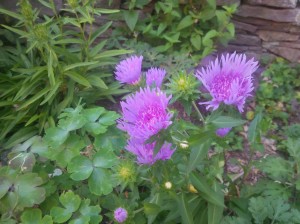
Pity the poor common chicory or Cichorium intybus, a Mediterranean native that has made itself at home all over the United States, gracing roadsides, field edges and other untended spaces. The semi-double daisy flowers are the most beautiful shade of sky-blue, but the stems are gangly and scraggly, with rough-looking toothed leaves. On top of all that, chicory blooms fold up and die the minute that you pick them, so unless you can arrange flowers at the speed of light and photograph the arrangement immediately, there is no use even snipping the stems. You can dig the roots to dry, grind up and use as a coffee additive, but doing so will deprive you of the fabulous, short-lived flowers. The ephemeral quality of chicory’s beauty is enough to drive a philosophical gardener mad.
There is, however, at least a partial remedy for this madness, and it comes to us courtesy of an early summer-blooming plant commonly known as Stokes aster. Unlike its close relative, chicory, Stokes aster is native to the American Southeast, where it favors damp areas and pine barrens. The flowers are fluffier—more like cornflowers or mums in appearance than daisies—but some Stokes aster or Stokesia laevis varieties feature blooms in the same heart-stopping shade of blue as chicory. All Stokesias boast handsome-looking stems and elongated dark green leaves. The cut flowers also last well in a vase.
Stokes aster is inextricably linked in garden history to another beautiful plant, foxglove or digitalis. Back in the freewheeling eighteenth century, an English physician/botanist named Jonathan Stokes became interested in the medicinal properties of digitalis. He conducted clinical trials on the drug and contributed to a groundbreaking book on the subject by fellow physician/botanist William Withering. The book, An Account of the Foxglove and its Medical Uses, published in 1785, helped spread the word about digitalis’ efficacy for the treatment of heart failure. While engaged in medicine, scholarship and botany, Stokes also became a member of London’s Linnaean Society, established to promulgate the work and philosophy of Carolus Linnaeus, father of modern plant taxonomy. In honor of Stokes contributions to botany and science, the genus Stokesia was named for him.
All kinds of plant-world luminaries are connected to Stokes asters. One of the old favorite varieties, ‘Klaus Jelitto’ is named for a well-loved twentieth century perennial plant breeder and seedsman. At eighteen inches tall and wide, ‘Klaus’ sports soft blue flowers atop erect stems. The whimsical-sounding ‘Peachie’s Pick’ originated as a chance seedling in a Mississippi garden owned by an avid gardener named Peachie Saxon. The Mississippi-born variety tops out at about two feet tall, with large, deep blue flowers. Like all happy Stokesias, ‘Peachie’s Pick’ forms nice-sized clumps within a few years. Deadheading helps prolong the bloom cycle, but if you leave a few heads to fend for themselves in mid-summer, the plants may self-seed nicely. I have no idea who “Mel” is or was, but I am longing to try ‘Mel’s Blue’, billed by one retailer as the bluest blue-flowered Stokesia. It would be a nice complement to ‘Honeysong Purple’, which is supposedly the “purplest” purple-flowered type.
‘Mary Gregory’ is something a bit different. Named for an avid Columbia, South Carolina gardener, and introduced in 1998 by North Carolina’s Niche Gardens, ‘Mary Gregory’ has soft yellow flowers and stems that are somewhat less erect than those of most blue-purple-flowered varieties. Those stems arch outwards and upwards to two-feet tall, with plants expanding to about eighteen inches wide. ‘Mary’ would be a great date for ‘Klaus’ or ‘Mel’ or even ‘Peachie’, providing neat color contrast in the garden. I may just move my ‘Mary’, which is only doing middling well in a lightly shaded spot, to a happier location next to my new ‘Blue Danube’, a tall specimen, with slightly lax stems and medium blue flowers.
Though not named for anyone in particular, little ‘Elf’ is perfect for small spaces and container gardens. As hardy as its other Stokesia laevis relatives, ‘Elf’ grows only eight inches tall by twelve inches wide. The two-inch, blue-purple flowers are borne in large numbers and have the same keeping qualities as those of other Stokesias. Another shorter variety is white-flowered ‘Divinity’, bred in Florida and topping out at twelve inches tall. Since it is sweet and southern, it reminds me a little of divinity fudge, a traditional southern candy that derives its pale color from a quantity of egg whites and sugar. ‘Divinity’ the Stokesia is almost certainly less fattening than divinity fudge. However, a balanced life might easily include both.
Despite the vogue for smaller plants, some gardeners still need something a little taller for the middle to back of the border. For them there is ‘Omega Skyrocket’, towering over other Stokesias at up to three feet tall. The flowers are proportionally large, two to three inches of blue-purple glory.
Chicory is stunning left to its own devices and allowed to grow, untroubled, in places that suit it. Unexpected chicory sightings are a revelation in those parts of cities, suburbs and the countryside that writers used to call “waste places.” In your garden, get the same color effect from Dr. Stokes’ asters. Pair them with some yellow foxglove or Digitalis grandiflora and you will create a real tribute to the good doctor.
For an excellent mail order selection, try Niche Gardens, 1111 Dawson Road, Chapel Hill, NC 27516, (919) 967-0078, www.nichegardens.com.
- Stokesia–Stars of the mid-summer garden
